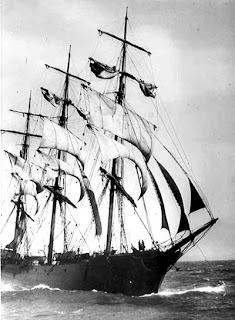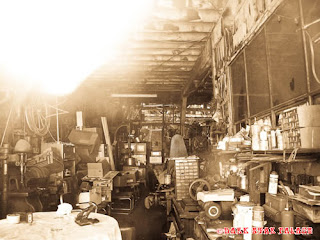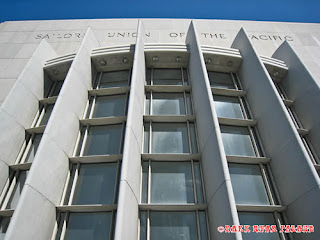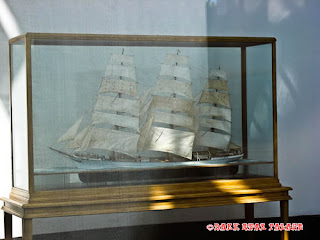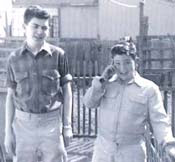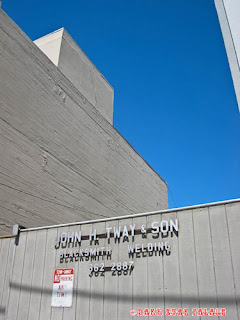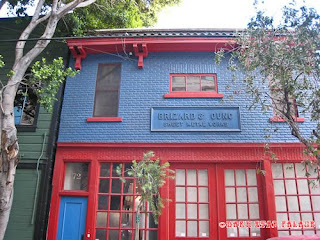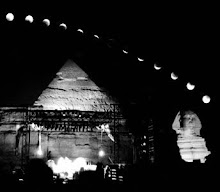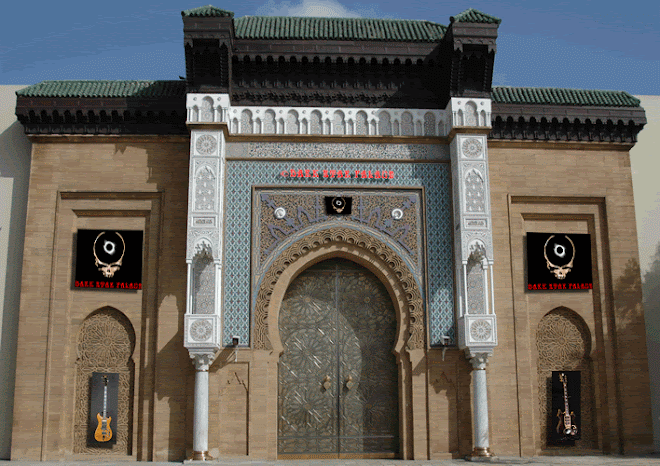Tape of the Week: Videos of Garcia/Dead Sea Shanties
This week, Dark Star Palace is going to kick off with a multiple choice trivia question: What place did Jerry Garcia consider to have the most influence on him?
A) the Chateau in Palo Alto
B) 710 Ashbury in San Francisco
C) the 400 Club in San Francisco
D) Olompali in Novato
B) 710 Ashbury in San Francisco
C) the 400 Club in San Francisco
D) Olompali in Novato

 This area of San Francisco has special meaning for Dark Star Palace, as I have lived and worked (and have been raising my own family) just a few blocks away from the 400 Club hood in a loft building down a seedy alley in SOMA for over the past decade. Couple this with my passion for the Grateful Dead and the fact that my great great grandfather was a whaling captain and my Norwegian great grandfather sailed around the world for decades on tall ships doing amazing carvings and scrimshaw from the time he threw a snowball at the King of Norway's face at the age of 7 years old and thus was forced into exile by the village and into a life sailing the 7 seas and surviving several shipwrecks (true story)....well, we'll just say I have it in my blood to love the high seas, anti-authority attitudes, old San Francisco and the gritty 'ole Grateful Dead.
This area of San Francisco has special meaning for Dark Star Palace, as I have lived and worked (and have been raising my own family) just a few blocks away from the 400 Club hood in a loft building down a seedy alley in SOMA for over the past decade. Couple this with my passion for the Grateful Dead and the fact that my great great grandfather was a whaling captain and my Norwegian great grandfather sailed around the world for decades on tall ships doing amazing carvings and scrimshaw from the time he threw a snowball at the King of Norway's face at the age of 7 years old and thus was forced into exile by the village and into a life sailing the 7 seas and surviving several shipwrecks (true story)....well, we'll just say I have it in my blood to love the high seas, anti-authority attitudes, old San Francisco and the gritty 'ole Grateful Dead.We'll start the tour by visiting the oldest remaining shop that supported the ships and sailing community around Rincon Hill from the 1920's until the present day.... Klockars' Blacksmith Shop. My sister first took me here about 15 years ago. Wow! This shop makes you feel like the gold rush just ended. Klockars is just a block away from the 400 Club, and one can just imagine Jerry strolling down 1st street to check out the handiwork that was going on inside. If you visit San Francisco, be sure to have a swig of rum and go check this treasure out. Argggh!!
 So where to start? Jerry's dad, Jose Garcia, first opened up a bar at the top of Rincon Hill, at the corner of 1st and Harrison Street, in San Francisco in 1937 after he had been booted out of the musicians union due to taking on some unauthorized non-union gigs (Joe used to play down the street at the Warfield in his musician days...just as Jerry and the Grateful Dead would decades later). So after Jose decided to move out of the music business, he switched gears and opened up his own bar and named it "Garcias." Garcia's proved to be a very successful bar, primarily due to all the drunk sailors that would frequent the bar due to its strategic location just up Harrison Street from the Bay Bridge and the San Francisco Wharf.
So where to start? Jerry's dad, Jose Garcia, first opened up a bar at the top of Rincon Hill, at the corner of 1st and Harrison Street, in San Francisco in 1937 after he had been booted out of the musicians union due to taking on some unauthorized non-union gigs (Joe used to play down the street at the Warfield in his musician days...just as Jerry and the Grateful Dead would decades later). So after Jose decided to move out of the music business, he switched gears and opened up his own bar and named it "Garcias." Garcia's proved to be a very successful bar, primarily due to all the drunk sailors that would frequent the bar due to its strategic location just up Harrison Street from the Bay Bridge and the San Francisco Wharf.  This area was quite a rough and tough 'hood back in the 30's, 40's and 50's. Across the street from Garcia's was the Sailors' Union of the Pacific, which all the seamen in San Francisco would frequent for work, union cards, etc. From the Sailors' Union website: "The origins of the Sailors' Union of the Pacific go back to March 6, 1885, when the Coast Seamen's Union was organized on the San Francisco waterfront by a group of three hundred sailors dissatisfied by the wages and conditions aboard ship that existed at that time. In 1886, the Steamship Sailors' Union was organized and in 1891 merged with the Coast Seamen's Union to form the Sailors' Union of the Pacific. The reasons for that merger are clearly stated in the preamble to the SUP Constitution: "...having been organized separately... and having thoroughly learned the value of organization, and further, that two organizations of the same craft are not for the best interests of men working at the said craft, we have determined to form one Union..." The Sailors' Union of the Pacific has been in continuous operation, through good times and bad, for over 121 years-an achievement unequaled by any maritime union in the world."
This area was quite a rough and tough 'hood back in the 30's, 40's and 50's. Across the street from Garcia's was the Sailors' Union of the Pacific, which all the seamen in San Francisco would frequent for work, union cards, etc. From the Sailors' Union website: "The origins of the Sailors' Union of the Pacific go back to March 6, 1885, when the Coast Seamen's Union was organized on the San Francisco waterfront by a group of three hundred sailors dissatisfied by the wages and conditions aboard ship that existed at that time. In 1886, the Steamship Sailors' Union was organized and in 1891 merged with the Coast Seamen's Union to form the Sailors' Union of the Pacific. The reasons for that merger are clearly stated in the preamble to the SUP Constitution: "...having been organized separately... and having thoroughly learned the value of organization, and further, that two organizations of the same craft are not for the best interests of men working at the said craft, we have determined to form one Union..." The Sailors' Union of the Pacific has been in continuous operation, through good times and bad, for over 121 years-an achievement unequaled by any maritime union in the world."  The Sailors Union, which opened in 1950, proved to be a real boon for the Garcia's. By having the Union headquarters directly across the street, the number of sailors who were "buying beer at 6AM" (as Jerry's brother Tiff said), made the Garcia's "400 Club" the number one bar in San Francisco for alcohol sales!! I find the fact that Jerry's family ran the #1 San Francisco booze house just amazing...especially as Jerry basically swore off alcohol for most of his life! Perhaps that is why! Anyhow, in 1947, everything changed as Jerry's dad drowned in the Trinity River in Northern California while fishing (Jerry claimed he watched all this go down....). This meant that momma Ruth now ran "Garcias" and had less and less time to keep an eye on Jerry and Tiff. That meant mischief was brewing in the young Jerry mind!
The Sailors Union, which opened in 1950, proved to be a real boon for the Garcia's. By having the Union headquarters directly across the street, the number of sailors who were "buying beer at 6AM" (as Jerry's brother Tiff said), made the Garcia's "400 Club" the number one bar in San Francisco for alcohol sales!! I find the fact that Jerry's family ran the #1 San Francisco booze house just amazing...especially as Jerry basically swore off alcohol for most of his life! Perhaps that is why! Anyhow, in 1947, everything changed as Jerry's dad drowned in the Trinity River in Northern California while fishing (Jerry claimed he watched all this go down....). This meant that momma Ruth now ran "Garcias" and had less and less time to keep an eye on Jerry and Tiff. That meant mischief was brewing in the young Jerry mind! In 1954, Ruth and family had to leave Garicas at 425 First Street as Union Oil decided to build their office headquarters on the site. Here's a bit of info on this building (which was recently ripped down in the mid-1990's so that the Rincon Hill Towers could be built...and good god, have you seen this new Rincon monster? I guess you can't miss it as it is now one of the tallest buildings in San Francisco). Here's some info on this old building:
In 1954, Ruth and family had to leave Garicas at 425 First Street as Union Oil decided to build their office headquarters on the site. Here's a bit of info on this building (which was recently ripped down in the mid-1990's so that the Rincon Hill Towers could be built...and good god, have you seen this new Rincon monster? I guess you can't miss it as it is now one of the tallest buildings in San Francisco). Here's some info on this old building:
 "The Union Oil Company Oil Building is a two-part Art Moderne office block with adjoining tower. The vertical tower — in the shape of a pylon — provides an excellent counterpoint to the office block, characterized by horizontal window bands on a glazed white tile facade. Blue belt courses and glass block windows accentuate the streamlined office design. Its architect, Lewis Hobart, took advantage of an elevated site to design a 138-foot triangular tower, whose white cladding was relieved by a vertical blue strip and orange triangle bearing the name of the company. In 1995, the Union Oil Company logo was replaced with a logo for the Bank of America, and the blue strip was removed. The tower is not only an advertisement, but also the most prominent point of reference for Rincon Hill. A great digital clock also displays the time to travelers enroute to the Bay Bridge or nearby freeways. Since portions of the site are used for parking and vehicular movement, the site could accommodate additional development consistent with the scale and character of the existing building."
"The Union Oil Company Oil Building is a two-part Art Moderne office block with adjoining tower. The vertical tower — in the shape of a pylon — provides an excellent counterpoint to the office block, characterized by horizontal window bands on a glazed white tile facade. Blue belt courses and glass block windows accentuate the streamlined office design. Its architect, Lewis Hobart, took advantage of an elevated site to design a 138-foot triangular tower, whose white cladding was relieved by a vertical blue strip and orange triangle bearing the name of the company. In 1995, the Union Oil Company logo was replaced with a logo for the Bank of America, and the blue strip was removed. The tower is not only an advertisement, but also the most prominent point of reference for Rincon Hill. A great digital clock also displays the time to travelers enroute to the Bay Bridge or nearby freeways. Since portions of the site are used for parking and vehicular movement, the site could accommodate additional development consistent with the scale and character of the existing building."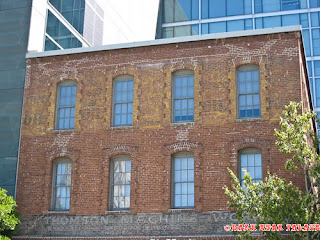 So after the Garcia's moved across the street to 400 1st Street, and thus renamed the bar "the 400 Club," and moved into the top floor apartment, Jerry got to work on spending his day's hanging out downstairs with the sailors while his mom poured beer and kept the bar rollin'. You can just imagine a young 12-year old Jerry sitting down at the bar listening to tales from sailors about being Shangheid and whisked away, off to sea and to distant and exotic lands...as well as hearing sea chanties being sung day and night by drunk seamen....Yes, Off to Sea Once More!!
So after the Garcia's moved across the street to 400 1st Street, and thus renamed the bar "the 400 Club," and moved into the top floor apartment, Jerry got to work on spending his day's hanging out downstairs with the sailors while his mom poured beer and kept the bar rollin'. You can just imagine a young 12-year old Jerry sitting down at the bar listening to tales from sailors about being Shangheid and whisked away, off to sea and to distant and exotic lands...as well as hearing sea chanties being sung day and night by drunk seamen....Yes, Off to Sea Once More!!Interestingly, there are stories of a tape of Jerry and his cousin, Daniel Garica, recording a rough jam version of Bobby Freeman's "Do You Wanna Dance" at the 400 Club in the Garcia's top-floor apartment (after Jerry moved to guitar from accordion!). According to several accounts, Jerry Garcia played guitar on the original Bobby Freeman recording of "Do You Wanna Dance?" in 1958 at the age of 15!! Here's some info I dug up on this:
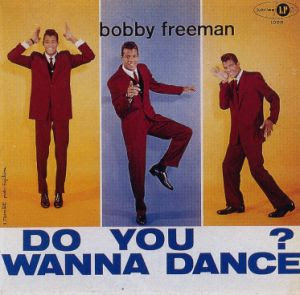
"The fullest account comes from David Nelson, quoted in Robert Greenfield's "Dark Star: An Oral Biography of Jerry Garcia" (pp63-64): "We all knew that he'd played electric guitar on Bobby Freeman's 'Do You Wanna Dance.' Before any of this. Before the folk thing. When he was in high school. In a real funky studio. If you listen to that recording, there are no drums. There are cardboard boxes. He was a kid from Balboa High. It was what he used to refer to as his 'teenage hoodlum period.' When he got that first electric guitar from his mom in exchange for the accordian. He got that guitar and was really happy with it and he told me that he just tuned it to one tuning. The solo actually sounds like it could be in that tuning because he said it wasn't until a couple of months later when he found out how to really tune it. It's very primitive and it's very much that style of plunging out and jumping in with both feet first. The solo itself is basically two licks used very modestly. Very modestly."
Sara Ruppenthal Garcia backs this up in the same book (p36): "And in high school, Jerry had played on Bobby Freeman's 'Do You Wanna Dance.' But he didn't consider that exactly worthy. What he really wanted to do was play with Bill Monroe." No mention of this is made in either Blair Jackson's "Garcia" An American Life" or Dennis McNally's "A Long Strange Trip." Rock Scully, in "Living With The Dead" says (p70): "[Tom Donahue] has his own label, Autumn Records ... Garcia has done session work for Autumn Records (including Bobby Freeman's single "Do You Wanna Dance?") so Tom already knows him."
Phil Lesh also mentioned it in an interview linked to the 2004 publication of his book "Searching For The Sound": "Well interestingly enough, Jerry's first instrument was rock and roll guitar. He played guitar on the Bobby Freeman song "Do You Want To Dance' when he was sixteen years old or something. It's like a rhythm guitar part." What is odd about this story is the timing. Jerry Garcia would have been 15 when "Do You Wanna Dance?" was recorded, and had been playing the guitar for less than a year. The liner notes from a Bobby Freeman CD give this account of how the song was recorded: "Bobby decided to visit the disc jockey on his own, taking with him a drum-playing friend ... Bobby accompanying himself on piano and his friend beating out the rhythm on the congas demonstrated his wares on four numbers, which the deejay took away with him. The vice president of Jubilee Records of New York was honeymooning in San Francisco and combining business with pleasure called in at the local radio station to see how his company's products were faring. The deejay instead played him Bobby's tape, and Mortimer Pailitz liked what he heard and within three weeks, Bobby was signed to Jubilee. They took the original tapes that Bobby had cut in Frisco, overdubbed a guitar, bass and drums, and released two of the tracks [including Do You Wanna Dance] on their Josie subsidiary in March 1958."
Now, before we head off to sea, the Palace is going to leave you with two tasty videos of Garcia and gang doing one of the great songs about a wharf: Wharf Rat, as well as a final little tale about sweet Peggio, a Lost Sailor and some Whiskey in the Jar.....enjoy.
Until next time at Dark Star Palace!

